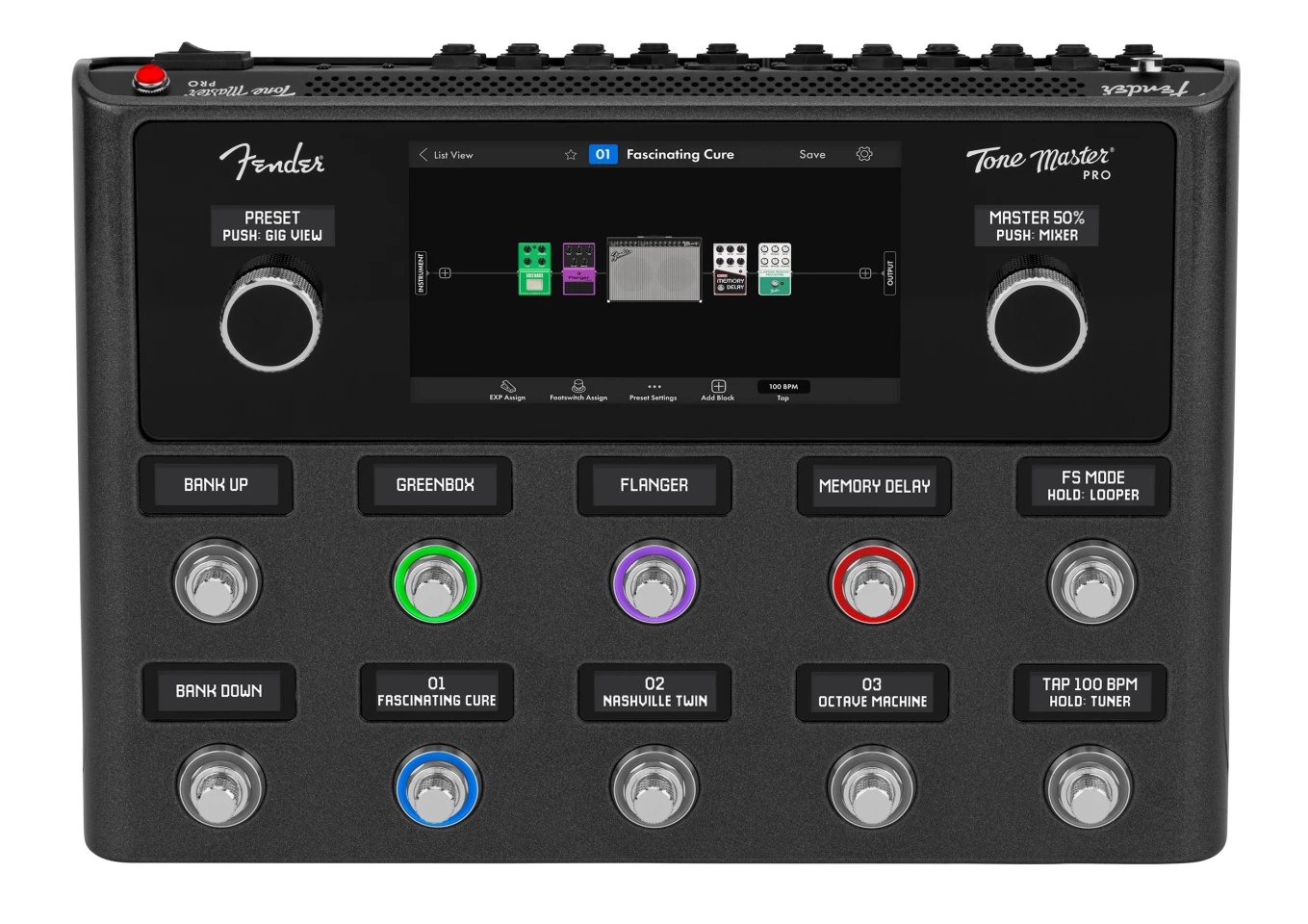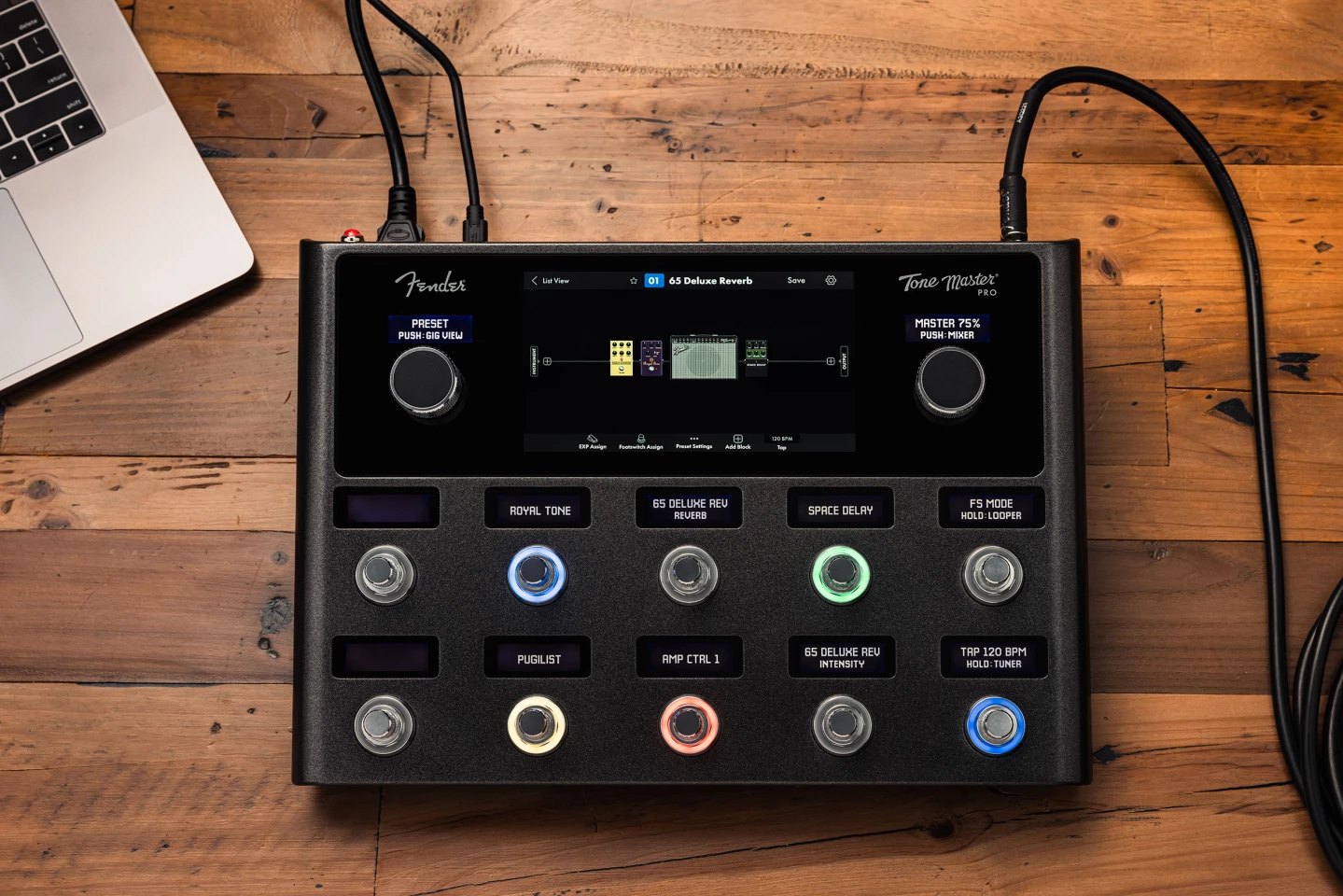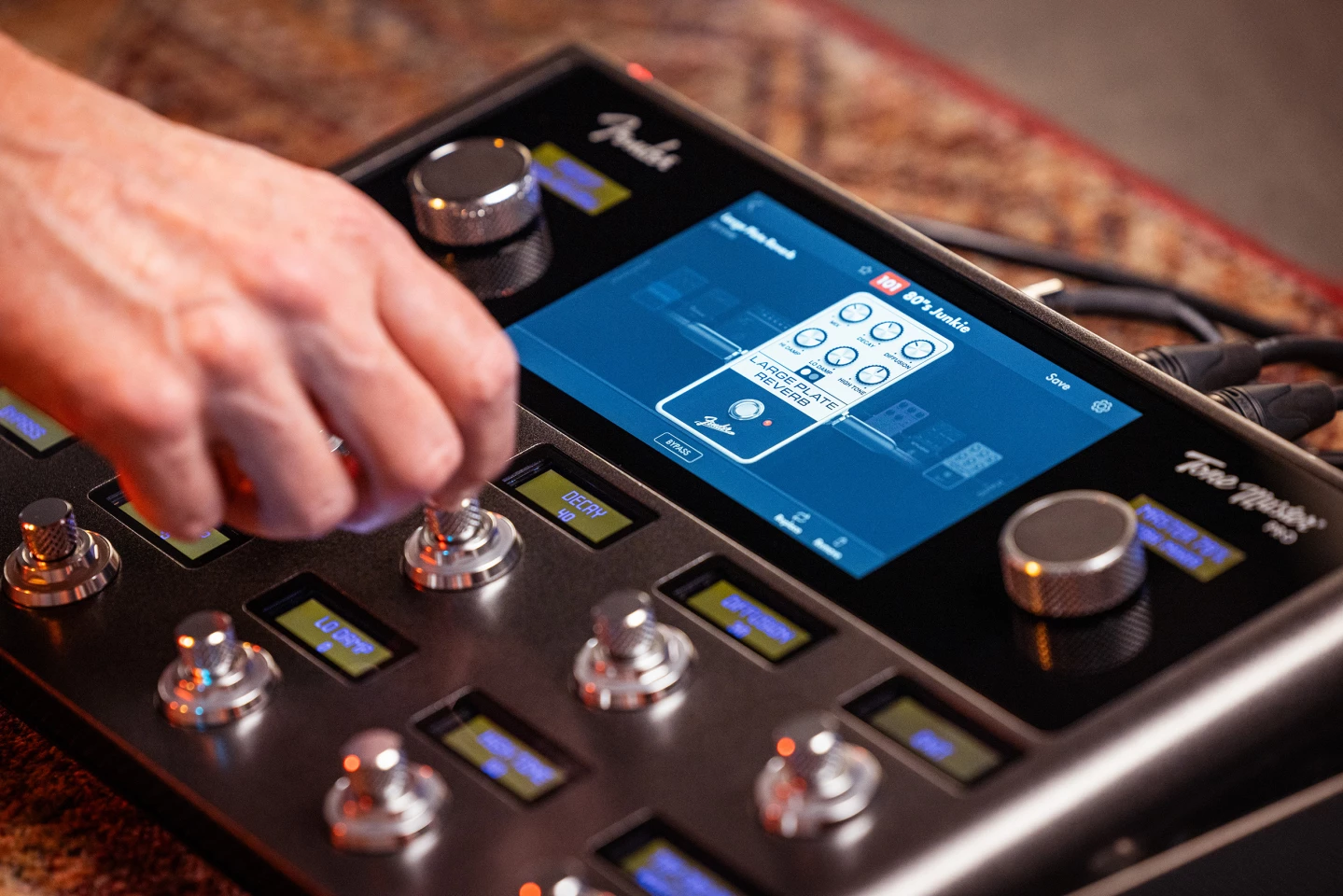Tube-driven guitar amplifiers are outstanding pieces of music equipment, but they're also heavy, bulky, somewhat delicate and they require some maintenance over the years. They're a little tricky to record with consistency, and each one delivers a relatively limited tonal palette.
But they're also essentially black boxes: you put this sound in, you should get that sound out. And in the digital age, a huge range of hardware and software products have sprung up that attempt to recreate the essential tone equation of tube amps as ones and zeros, delivering simulated amp tones immediately ready for recording, or fuss-free live playing. Tube amps will always be popular, but digital amp simulators are one of the hottest rising trends in the business.
They come in two broad flavors. In the modeling camp sit devices like Fractal's FX9, Line 6's Helix series, Boss's GT1000 and the Headrush pedalboards, which attempt to recreate classic real-world amplifier circuits by building digital models of their componentry, and then running their signals through simulated speaker cabinets, capturing the results through simulated microphones that can be moved around just like a recording sound engineer would in a studio.
In the capturing/profiling camp sit devices like the Kemper Profiler, Neural DSP's Quad Cortex, and IK Multimedia's ToneX pedal. These take a different approach, allowing guitarists to build digital models of their own guitar rigs based purely on AI algorithms that listen to what goes in and what comes out, and give you a black box that attempts to simply do the same thing to a given signal.

Both of these approaches are delivering stunning results, and all of the devices above – plus many, many others – give you a single unit, much smaller and more portable than your average cab 'n' quad box, that contains a huge range of amplifiers, all highly tunable to your tastes, as well as great scads of effects pedals and rack units, signal chain options and professionally-designed presets to get you started.
Fender's Tone Master series, when it launched in 2019, was different. Rather than offering a wide range of amp models, Tone Master amps focused all their processing power on recreating one single classic Fender amplifier. Storied combo amps like the Twin Reverb, Super Reverb, Deluxe Reverb and Princeton Reverb were all recreated in Tone Master format, complete with neodymium speakers, and cabinets that looked just about identical to the real deal.
They were about half the weight, and often much less than half the price of the real deal, though. They didn't sound or feel exactly the same, but they were close enough to keep a lot of people guessing. Unlike the original amps, you could make them sound like they were really pushing without needing the volume up. They also offered a direct signal out that could be sent straight to a computer, complete with mic and cab modeling, for recording.
The Tone Master amps do one thing well, but they only do that one thing. They can't be kept fresh and exciting and inspiring with the kind of downloadable updates you'd get on the Helix series, for example, which often come with lots of brand-new amp models. And there's limited opportunity for ongoing monetization, in terms of selling upgrades like Neural DSP will eventually get around to doing with the Quad Cortex.

And thus, enter Fender's latest beast: the Tone Master Pro. This is no longer an all-in-one amp; it's a digital floor unit that combines all the previous Tone Master models, as well as a range of effects pedals, signal chain options, microphone processing gear, a monstrous range of input and output options, a built-in 60-second looper, and enough processing power to run stupid numbers of effects and amps simultaneously.
As such, it can't avoid comparison to other floor units that have been around for years. It runs a gorgeous touchscreen that shows your entire setup graphically, much like the Headrush Prime. It gives you 10 stomp pedals, spaced far enough apart for bigfoot types to hit with reasonable accuracy on a dark stage – but these stomp switches are also encoder knobs that can be turned to vary an assortment of amp and pedal parameters... Much like the Quad Cortex – albeit with eight processing cores instead of four.
In form factor alone, though, it looks closest to the Line 6 Helix, particularly thanks to LED rings around each stomp pedal with assignable colors, and digital scribble strips above them – both allowing guitarists to tell at a glance what each pedal is set up to do at a given moment.
Like most of these jiggers, you can run it directly into a PA system, or a computer, or an FRFR (full-range, flat response) speaker designed to put sound into a room much like a normal amp cab might. You can even run it in and out of a regular guitar amp through an effects loop, allowing you to combine all your digital affects and amp models with real effects and amp circuitry, with a ridiculously flexible signal chain, and then run the result out through a real power amp and cabinet.

So what's it like?
Well, the 7-inch touchscreen interface, complete with nicely rendered illustrations of a range of amps and pedals, will be a huge enticement for many buyers. Options like the Fractal FM9 are notoriously difficult and fiddly to set up, and even the popular Helix and Quad Cortex take a non-graphical, parameter-based UI approach that feels far more techy than artistic. Many folk find these other devices easier to experiment with and dial in though a desktop app.
The Tone Master Pro is a big step forward in that regard. It may well be the easiest modeler on the market to tune your sound on through the onboard controls alone, and I suspect many players will prefer this to whatever the desktop or mobile apps end up looking like. The scribble strips and colored rings make it easy to figure out where your foot needs to go while you're playing.
So the interface gets a solid A minus, only really losing points for small, fixable issues. Like, the touchscreen keyboard that comes up when you're naming a preset, which covers up the Save button until you hide the keyboard. Or the fact that the color rings around the pedals can't dim themselves to show their off and on states. Or the fact that sometimes, pop-in/pop-out animations on the touchscreen take just long enough to get in your way.
The built-in tuner is one of the better ones I've seen, although given the existence of the Polytune range of pedals, I'm a bit bummed that the latest, greatest floor units still make you do things one string at a time. A global EQ page lets you quickly tune the entire unit to make your presets work on a new stage, which is nice, and while it doesn't have its own expression pedal built in, it'll work with a range of third party units. There's a built-in mixer as well, complete with a multi-channel wet/dry USB recording interface.

And so to the tones it claims to master. The Tone Master Pro offers 29 component-modeled amps at launch. That includes 11 of Fender's own electric and Acoustasonic amps, as well as models of all three channels of the EVH 5150 amp – which Fender owns the rights to. The Bassman, Bassbreaker, Vibro-King and Blues Junior are all represented, as well as all the previous Tone Master models.
And then there's amps from other companies; Fender's versions of the Marshall Plexi, Silver Jubilee and JCM800, the Vox AC30, various Mesa Boogie amps, the Roland Jazz Chorus, the high-gain Bogner Uberschall and the delightfully-named Friedman BrownEye 100, complete with a Hairy BrownEye switch.
What there's not is any kind of Dumble Overdrive-style amp, or a Soldano, or an ENGL, or a Trainwreck, any of the more boutique modern cleans like those from Divided by 13, Supro, Dr. Z, or Matchless. Worse still, Fender's own Tweed range of crunchy goodness gets fairly scant attention.
I use the above examples, because all of them are available on the Line 6 Helix, and it illustrates the challenge Fender is up against as it launches this product. The Helix has been around for a whole eight years now, and Line 6 has furnished it with frequent updates. As of today, my Helix LT has somewhere around 90 guitar amp models in it... Plus 15 bass amps, where the Tone Master Pro has none.

That's at launch, of course. "That'll obviously continue to grow as we release new firmware updates," said Jason Stilwell, Director of Product for Fender Amps, in an online media launch. "Every amp, every effect model is Tone Master quality. We've done everything to that standard, using a component-based modeling process based on the schematics for these things. We model these amps and effects down to the resistor and capacitor. They match the original one-to-one. Each amp model takes about three months from the time that the engineers start coding it, through multiple listening tests and iterations until we're all confident that we've nailed it."
"We're planning on doing updates, basically every six months for a long time," he continued. "We're very excited to actually get started on some of that post-launch content."
In terms of sound, well, that's obviously subjective, but the massive processing power here is put to excellent use. The Fender Blackface range all sound great to me, and the new Fender models are welcome additions. The '59 Bassman lets you take the Fender concept into some pretty aggressive territory without adding pedals, and the high-gain Bassbreaker channel rips like a fart on a plastic chair. Excellent fun.
And I certainly don't feel like Fender has phoned it in or sandbagged when it comes to modeling other companies' amps. The Marshalls sound nice and chewy and organic, the Vox models capture the requisite chime, and the EVH and Friedman models take me as far as I need to go into higher-gain territory with plenty of flexibility and bite.
I'm not gonna lie, I rarely play with Mesa Boogie models in any of my modelers, I just don't get the Dual Rectifier thing. I will say I dislike this one less than the Helix model, at a glance. Likewise I'd be more likely to switch to kazoo than deliberately call up the cutting sizzle of the Uberschall or the... Whatever's supposed to be going on with the Jazz Chorus.
Honestly, I feel like I'd get a ton out of this unit even if it only had the superbly squishy Deluxe Reverb and the gorgeously chuggy, woody BrownEye in it. Have a listen to it in the video below.
As a general comment, I'd say the Tone Master Pro amp models are touch-responsive, musical and very flexible once you start playing with settings. They take pedals beautifully, either digital ones or outboard pedals running before the amp or in the effects loops. Connected to Fender's own Tone Master FR-12 cabinet, which launches alongside the floor unit, these amps can really move some air, delivering a surprising amount of transient punch when you ask for it. They feel superb to play,
As for the effects, well, there are loads of them, and they're terrific too. I'd call attention to the Strymonesque Cloud reverb pedal, which can deliver some gorgeous ambient tails, and a terrific selection of fuzz pedals, including a truly apocalyptic sounding germanium pedal that mangles guitar tones with chaotic disrespect.
There's also a very fun Tom Morello-style whammy pitch shifter, a feedback generator, stereo orbit generators, and EQs, delays, choruses, flangers, phasers, noise gates, wahs, harmonizers, vibratos, tremolos and rotary speaker emulators up the wazoo.
Plus a nice selection of overdrives, distortion and boost pedals, naturally, with plenty of favorites on board at launch, from Tube Screamers, to Klons, to RATs, Blues Breakers, Princes of Tone and the familiar orange Boss DS-1. All these pedals are highly editable, either through the touch screen or using the encoder knobs below – and the stomp pedals can be set up in some very flexible ways, controlling multiple parameters across multiple amp and effect boxes at once rather than being limited on/off switches.
Fender has set up 130-odd factory presets, which show off some pretty fancy setups and weird sounds, as well as others that are more song-specific. There's also a cloud full of user- and artist-uploaded presets to try out and download through the desktop app.

With splittable, rejoinable stereo signal paths, you can run stereo multi-amp stacks with crazy amounts of effects, and the Tone Master Pro's 8-core processor barely bats an eyelid – although if you get really silly, some latency starts to creep in. By default, all your reverb and delay trails spill over when you select new patches, because the unit has enough grunt to run two patches simultaneously during the crossover.
Solo acts will also appreciate the ability to add an additional signal chain to run a microphone and vocal effects at the same time, including 48-volt phantom power if you're using a condenser mic. Mind you, it's fair to say that the Headrush Prime has the wood on the Tone Master in this aspect, given its built-in real-time Antares Autotune software. Not that any of us need that kind of thing. Ahem.
The Tone Master Pro is a terrific multi-effects and amp modeling floor unit. It's built tough and appears roadworthy, and while it's not the most compact or lightweight unit in its class, it's smaller than some and decently portable. Live, at home or in the studio, it offers a shedload of sumptuous, high-quality tone options, and the ability to customize your sounds to a huge degree.

But it's not alone in these aspects, and at a launch RRP of US$1,699 (AU$2,749 in Australia), it's late to the party and priced right up against well-established top-shelf competitors like the Helix, the Quad Cortex, the Fractal FM9 Turbo and others. They might not have the same muscle, but all of these things sound great; you'd really need to split the difference on a model-by-model, back-to-back basis, where my feeling is the Tone Master Pro is more likely to shine than dominate. And all of the competition offer a ton more models in 2023 than Fender can at launch.
There is, however, a heck of a lot to be said for a good interface – and the Tone Master Pro's highly graphical touchscreen helps it stand out as one of the most user-friendly and tactile units on the music store shelf. I think Fender can rightly claim to have built "the most powerful and easiest-to-use guitar processor ever." With a desktop app built, and a Bluetooth mobile app on the way, the hardware and software feel solid, and it's up to Fender's modeling team from here to start smashing those updates out and flesh out the sonic catalog.
As for the FR cabinets, I reckon they'll be clear-cut winners. In 10- and 12-inch speaker options, they offer 1,000 watts of high-headroom volume, along with EQ and cut knobs, in a relatively lightweight and portable unit that looks like a Fender speaker cab, and rocks back onto a set of flip-out legs to act as a stage foldback unit if you need it to.
They sound terrific with the Tone Master Pro, and work beautifully with other floor units and digital setups as well. And the price here places little impediment: US$499 and $549 for the 10 and 12 inch versions respectively (AU$849/$1049 in Australia). Check out another short video below.
Source: Fender













